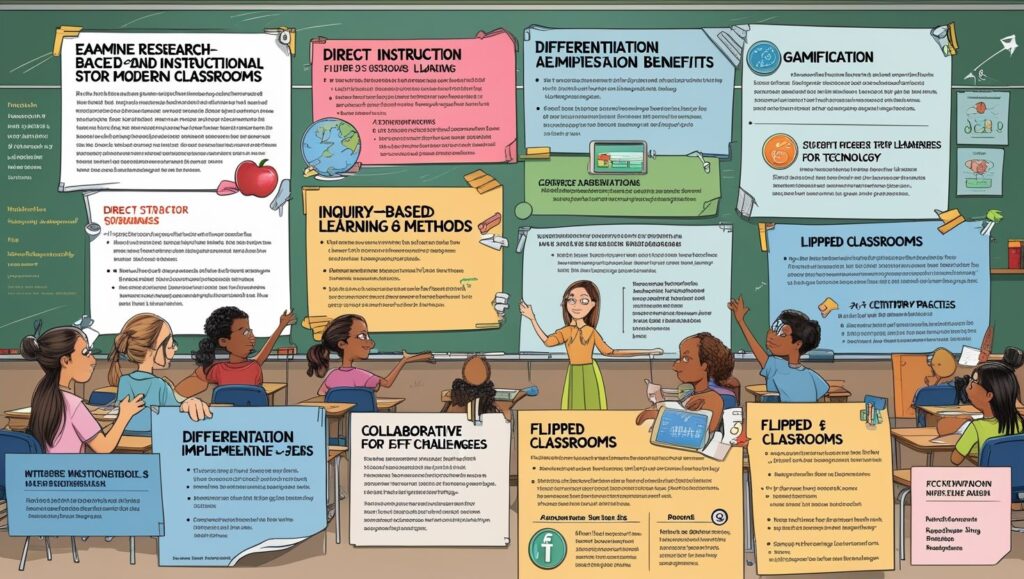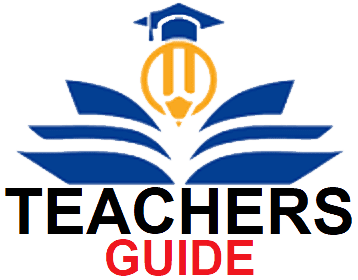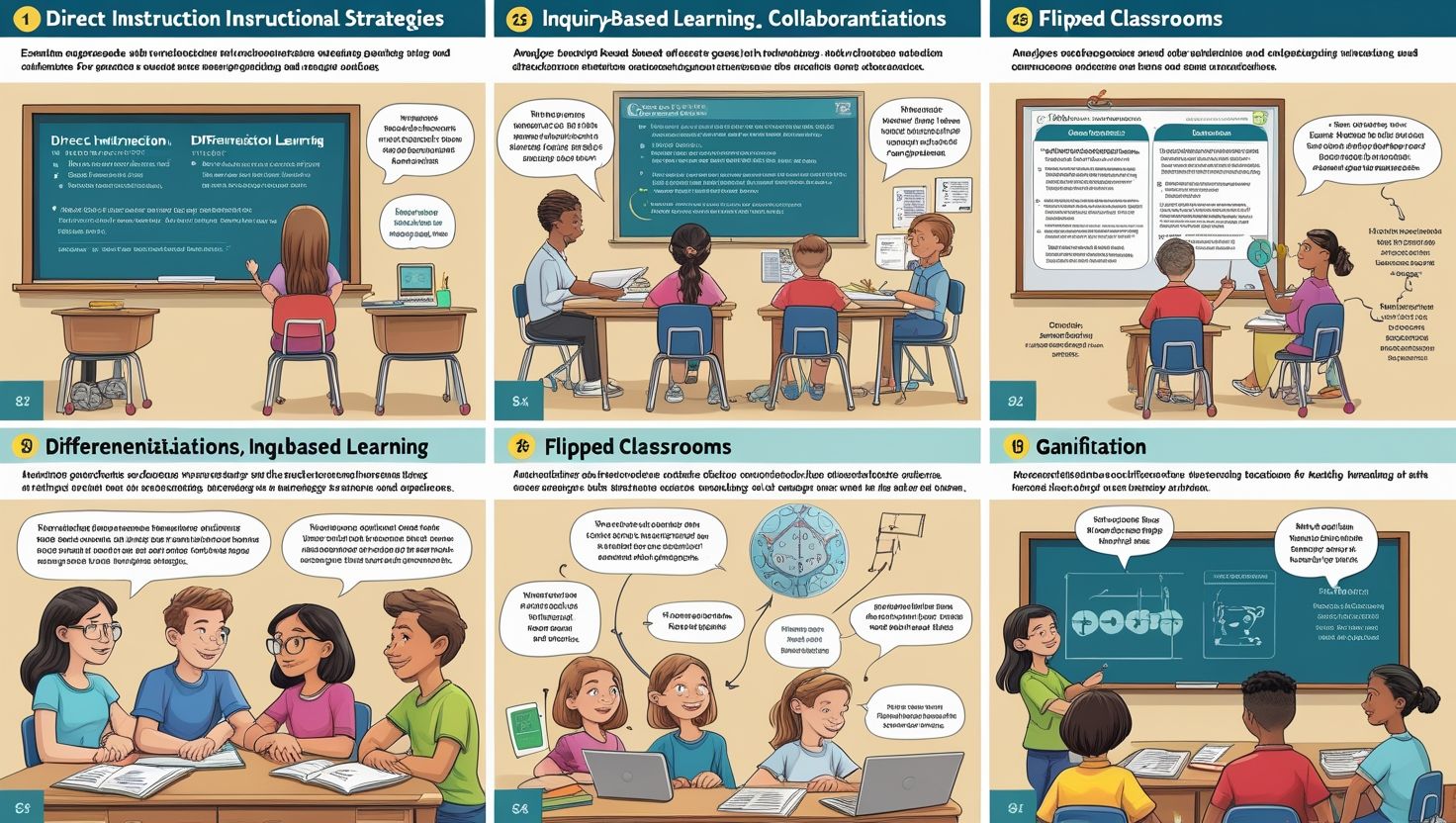Introduction
Effective Instructional Strategies for Classrooms, Instructional strategies are the cornerstone of effective teaching, shaping how educators deliver content, engage students, and assess learning outcomes. In today’s diverse classrooms, teachers must employ evidence-based methods that cater to varying learning styles, cultural backgrounds, and cognitive abilities. Research indicates that strategic instruction enhances knowledge retention, critical thinking, and student motivation (Hattie, 2017).
This article examines seven research-backed instructional strategies, their theoretical foundations, and practical applications across disciplines. Each section provides a 280-word analysis of the strategy’s implementation, benefits, and challenges, supported by case studies and empirical data. The discussion progresses from direct instruction to innovative approaches like flipped classrooms and gamification, concluding with recommendations for teacher professional development. By synthesizing educational psychology with classroom practice, this paper serves as a comprehensive guide for educators seeking to optimize their pedagogical toolkit in alignment with contemporary learning standards.
Direct Instruction: Structured Knowledge Transmission
Direct instruction remains one of the most efficient methods for delivering foundational knowledge, particularly in STEM subjects. This teacher-centered approach follows a clear sequence: learning objectives presentation, modeled demonstration, guided practice, and independent application (Rosenshine, 2012). A meta-analysis of 300 studies revealed that direct instruction improves standardized test scores by 0.59 standard deviations, outperforming discovery-based methods (Stockard et al., 2018). For example, in teaching fractions, educators might first define terms, demonstrate problem-solving on the board, then supervise peer practice before assigning individual work. However, critics argue this method may limit creativity if overused. To mitigate this, teachers can integrate brief inquiry segments—such as asking students to derive alternative solution paths—within the structured framework. Successful implementation requires meticulous lesson scripting and frequent checks for understanding through formative assessments like exit tickets.
When combined with multimedia tools like Khan Academy videos, direct instruction becomes more dynamic. Key benefits include time efficiency and equity, as it provides all students with identical core content. Challenges involve addressing varied pacing needs; thus, supplementary scaffolding for struggling learners and enrichment tasks for advanced students are essential adaptations.

Inquiry-Based Learning: Fostering Critical Thinking
Inquiry-based learning (IBL) shifts the cognitive load to students through investigation-driven activities modeled on scientific research. The 5E framework—Engage, Explore, Explain, Elaborate, Evaluate—structures this approach (Bybee et al., 2006). A 2022 study in the Journal of Educational Psychology found IBL increases long-term content retention by 32% compared to passive lectures, as it activates metacognitive skills (Lazonder & Harmsen, 2022). In a high school biology class, students might hypothesize about plant growth under varied light conditions, design experiments, collect data, and present conclusions. This strategy aligns with constructivist theories, emphasizing knowledge construction through experience.
However, IBL requires significant preparation: teachers must curate resources, anticipate misconceptions, and provide guided prompts to prevent frustration. Time constraints pose another barrier; a hybrid model incorporating mini-lectures for complex concepts balances depth and curriculum coverage. Technology enhances IBL through virtual labs (e.g., PhET simulations) and collaborative platforms like Padlet for hypothesis sharing. Assessment focuses on process journals and peer feedback rather than traditional tests. While IBL demands more classroom time initially, its benefits in cultivating problem-solving autonomy justify the investment, particularly in STEM and social studies where analytical skills are paramount.
Differentiated Instruction: Meeting Diverse Learner Needs
Differentiated instruction (DI) tailors content, process, and product to accommodate individual readiness levels, interests, and learning profiles (Tomlinson, 2017). A three-tiered approach—whole-group introduction, small-group targeted instruction, and individualized tasks—ensures inclusivity. For instance, in a middle school ELA unit on persuasive writing, advanced students might analyze op-eds from The New York Times, while others use graphic organizers to structure basic five-paragraph essays. Research from the National Center on Accessible Educational Materials shows DI reduces achievement gaps by 45% in mixed-ability classrooms (CAST, 2020). Practical tools include learning stations, choice boards, and adaptive software like DreamBox for math. However, DI’s success hinges on diagnostic pre-assessments to identify skill variances—a challenge for overburdened teachers. Effective Instructional Strategies for Classrooms is very much important.
Streamlining is possible through “flexible grouping,” where students rotate through activities based on real-time performance data. Another barrier is resource disparity; open educational resources (OER) like CK-12 textbooks help bridge this gap. DI also fosters social-emotional growth by validating all learners’ contributions. For example, a history class debating immigration policies could assign roles (researcher, presenter, artist) matching strengths. While planning demands increase, template-driven lesson frameworks and peer coaching among staff make DI scalable. Ultimately, this strategy embodies equity in action, ensuring each student accesses curriculum rigor at their developmental level.
Collaborative Learning: Leveraging Social Constructivism
Collaborative learning operationalizes Vygotsky’s zone of proximal development by structuring peer interactions to scaffold understanding (Johnson & Johnson, 2009). Techniques like think-pair-share, jigsaw activities, and group projects cultivate communication and teamwork—skills prioritized by the OECD’s 2030 education framework. A seminal study by Springer et al. (1999) found collaborative methods boost academic performance by 0.51 standard deviations, with largest gains in literacy and second-language acquisition. In a jigsaw activity on climate change, student “experts” master subtopics (e.g., melting glaciers) then teach teammates, promoting accountability. Digital tools like Google Workspace enable real-time collaboration across locations. However, free-riding and conflict management are common pitfalls.
Clear rubrics assessing individual and group contributions mitigate this; for example, requiring each member to submit research notes before combining findings. Teachers must also model constructive feedback techniques to prevent dominance by high-achievers. Structured protocols like “round robin” ensure equal participation. Cross-age tutoring programs extend benefits beyond classrooms—secondary students mentoring elementary peers in reading show improved metacognition (Topping, 2022). While collaborative learning thrives in person, hybrid adaptations using breakout rooms maintain engagement. This strategy’s dual impact on academic and social-emotional learning makes it indispensable for preparing students for workforce demands centered on collective problem-solving.
Flipped Classroom: Maximizing Active Learning Time
Effective Instructional Strategies for Classrooms, The flipped classroom inverts traditional models by delivering direct instruction via pre-class videos, freeing class time for active learning (Bergmann & Sams, 2012). Meta-analyses indicate flipped instruction raises test scores by 0.35 standard deviations, with most significant improvements in higher education STEM courses (Chen et al., 2020). A high school chemistry teacher might assign 10-minute screencasts on atomic theory, then use lab sessions for hands-on modeling with 3D molecule kits. This approach accommodates self-paced review—students can rewatch videos—while enabling personalized teacher support during application. Challenges include ensuring all students complete pre-work; embedding brief quizzes in videos (via Edpuzzle) boosts accountability. Equity concerns around home internet access require alternatives like USB drives or library viewing stations.
Successful flipping also demands redesigning physical spaces: movable furniture facilitates station rotations between experiments, peer tutoring, and teacher-led clarification. Formative assessments like one-minute papers identify misconceptions to address during class. Higher-order tasks dominate face-to-face time—debating ethical implications of genetic engineering rather than copying DNA structure diagrams. Though initially labor-intensive to create video banks, collaborative teacher teams sharing resources alleviate this burden. The flipped model’s efficacy lies in its alignment with cognitive science principles: spaced repetition through pre-class exposure and deeper encoding via in-class elaboration.

Gamification: Enhancing Motivation Through Play
Gamification integrates game design elements—points, badges, leaderboards—into non-game contexts to increase engagement (Deterding et al., 2011). A 2023 Computers & Education study reported gamified classrooms saw 28% higher homework completion and 14% greater content mastery versus controls (Majuri et al., 2023). In a Spanish class, Duolingo’s streak counters and XP rewards incentivize daily practice, while Classcraft transforms behavior management into a role-playing adventure. Neuroscientific research confirms games trigger dopamine release, reinforcing persistence through failure—a key growth mindset component. However, superficial point systems without pedagogical alignment risk reducing intrinsic motivation.
Effective design ties mechanics to learning objectives; for example, a “virus outbreak” scenario in biology where students earn “antidote” badges by mastering immune system concepts. Platforms like Kahoot! and Quizizz offer low-barrier entry with pre-built templates. Long-term projects benefit from narrative arcs—a semester-long “space exploration” quest in physics where each unit unlocks new mission parameters. Critics caution against overemphasis on competition; cooperative modes where classes collectively unlock rewards (e.g., 90% quiz accuracy earns a movie day) foster inclusivity. Implementation requires balancing fun and rigor, but when executed well, gamification meets Gen Z’s digital-native expectations while advancing curricular goals.
Conclusion: Synthesizing Strategies for Professional Growth
Effective Instructional Strategies for Classrooms, Effective instruction requires strategic blending of methods tailored to content, context, and learner needs. As evidenced, direct instruction builds foundational knowledge efficiently, while inquiry and collaborative methods develop critical thinking. Differentiation and flipped classrooms address equity, and gamification taps into motivational psychology. However, teacher training remains the linchpin; a 2021 OECD report found only 38% of educators globally receive regular pedagogical upskilling. Schools must invest in PLCs (Professional Learning Communities) where teachers co-plan lessons integrating these strategies, supported by classroom observations and feedback cycles.
Universities should emphasize evidence-based practices in pre-service programs, moving beyond theoretical coverage to micro-teaching simulations. Policymakers can incentivize strategy adoption through funding tied to professional development participation. Ultimately, the goal is adaptive expertise—teachers fluidly selecting and combining approaches like a master chef spices a dish. With AI poised to personalize learning further, human educators’ role will increasingly center on facilitating these rich, strategy-driven experiences that no algorithm can replicate. The future of education belongs not to a single silver-bullet method, but to pedagogically agile teachers harnessing research to ignite every student’s potential.


Peculiar article, totally what I was looking for.
https://auctionwheels.info/cars/plymouth/models/neon/pagination/start
Way cool! Some extremely valid points! I appreciate you penning
this post plus the rest of the site is also really good.